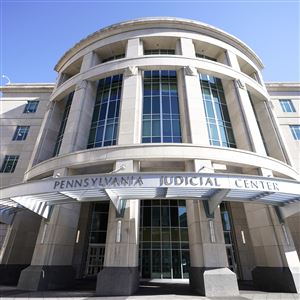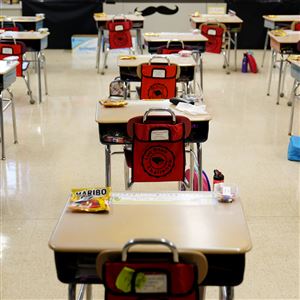A Commonwealth Court judge on Tuesday ruled that Pennsylvania’s school funding system is unconstitutional, a landmark decision that could funnel billions of additional dollars to school districts across the state.
The long-running lawsuit, first filed in 2014, argues that Pennsylvania’s funding of school districts is so inadequate that it violates the state constitution.
School funding relies heavily on local taxes, with only 38% of public education costs covered by the state. That system, the suit argues, creates per-student funding gaps between wealthier and poorer districts.
While the ruling won’t have immediate effects on school districts, it has big implications for the future of public school funding in Pennsylvania.
Here’s a look at the lawsuit, what happened, and what comes next.
What happened?
Commonwealth Court Judge Renee Cohn Jubilerer ruled the state hasn’t fulfilled its obligation to all children under the state constitution, because students in lower-income districts are “deprived of the same opportunities and resources” as students in wealthier districts.
As a result, she wrote in an almost 800-page decision, “students attending low-wealth districts are being deprived of equal protection of the law.”
Ms. Jubilerer said the plaintiffs successfully argued that wide achievement gaps on state assessments exist between students in wealthier and poorer districts. Those gaps, she said, widen for Black, Hispanic, English-language learners and economically-disadvantaged students.
The plaintiffs also proved, the court ruled, that the state’s Education Clause “was clearly, palpably, and plainly violated because of a failure to provide all students with access to a comprehensive, effective, and contemporary system of public education that will give them a meaningful opportunity to succeed academically, socially, and civically.”
What are people saying?
The Education Law Center and the Public Interest Law Center, which represented districts and parents that brought the lawsuit, called the ruling a "historic victory for Pennsylvania's public school children."
"The court recognized that our schools require adequate funding to meet our constitution's mandate," the law centers said in a statement. "It's time for our state legislature to fund public schools in every corner of Pennsylvania so all students, whether or not they live in a wealthy community, can receive the quality public education guaranteed in our state constitution."
Nathan Benefield, senior vice president of the conservative Commonwealth Foundation, said he was grateful that the judge left it to the legislature and executive branch to find a solution, rather than "mandating more money to a broken system."
"The only way to ensure that 'every student receives a meaningful opportunity' is for education funding to follow the child," Mr. Benefield said in his statement. "Students that are trapped in their zip-code assigned school — especially in low-income and minority communities — often have no alternatives when their academic or social needs are unmet."
How did this case start?
The lawsuit was filed in 2014 by six school districts, parents and various state organizations.
That included the William Penn, Panther Valley, Lancaster, Greater Johnstown, Wilkes-Barre and Shenandoah Valley school districts; seven parents with children in those districts and at the School District of Philadelphia; the NAACP Pennsylvania State Conference; and the Pennsylvania Association of Rural and Small Schools.
It was filed against legislative leaders, state education officials and the governor, but it was primarily defended by former state House Speaker Bryan Cutler of Lancaster County and former state Senate President Pro Tempore Jake Corman of Centre County.
After playing out in courts for years, the trial officially started in November 2021, kicking off what months of arguments resulting in thousands of pages of testimony.
Post-trial arguments were heard in July, officially wrapping up testimony in the case.
What were the arguments?
During the trial, the plaintiffs argued that the current system denies students the “thorough and efficient system of public education” as mandated by the state constitution.
During closing arguments, plaintiffs’ attorney Katrina Robson described testimony from throughout the trial of dilapidated buildings, classrooms located in closets, overcrowding and test results that showed students in poorer districts lagging behind students in better-funded schools.
But Republican leaders argued that school funding has been growing and is adequate.
Tom DeCesar, who represents Mr. Corman, argued that schools involved in the suit failed to prove they get the most out of the money they are already allocated. The defendants also dismissed the idea that there is a direct relationship between spending and student learning, while arguing that Pennsylvania does a better job at funding public schools than other states.
What happens next? Will there be an appeal?
The Public Interest Law Center and Education Law Center had expected an appeal if the Commonwealth Court ruled in their favor. The defendants haven’t yet said if they will appeal.
If there is an appeal, the case would go to the state Supreme Court.
Will this change how schools are funded?
The decision did not direct the legislature on how much state aid to distribute, or how to distribute it.
“The Court is in uncharted territory with this landmark case,” Ms. Jubilerer wrote. “Therefore, it seems only reasonable to allow Respondents … to devise a plan to address the constitutional deficiencies identified herein.”
Have other states seen similar lawsuits? What happened there?
Similar lawsuits have played out in New York and New Jersey.
A suit filed in 2014 in New York argued that the state never fully funded a 2007 Foundation Aid program, which takes school district wealth and student need into account to create an equitable distribution of state funding.
The state settled in 2021, requiring New York leaders to phase-in full funding of Foundation Aid by the 2024 budget.
A 1981 case in New Jersey directed state officials to provide adequate K-12 foundational funding, universal preschool for all 3- and 4-year-old children and funding of at-risk programs.
As a result, New Jersey was the first state to mandate early education. It also undertook the most extensive construction program in the country, which was designed to improve the quality of school buildings in low-wealth neighborhoods, according to the New Jersey-based Education Law Center.
First Published: February 8, 2023, 4:40 p.m.
























